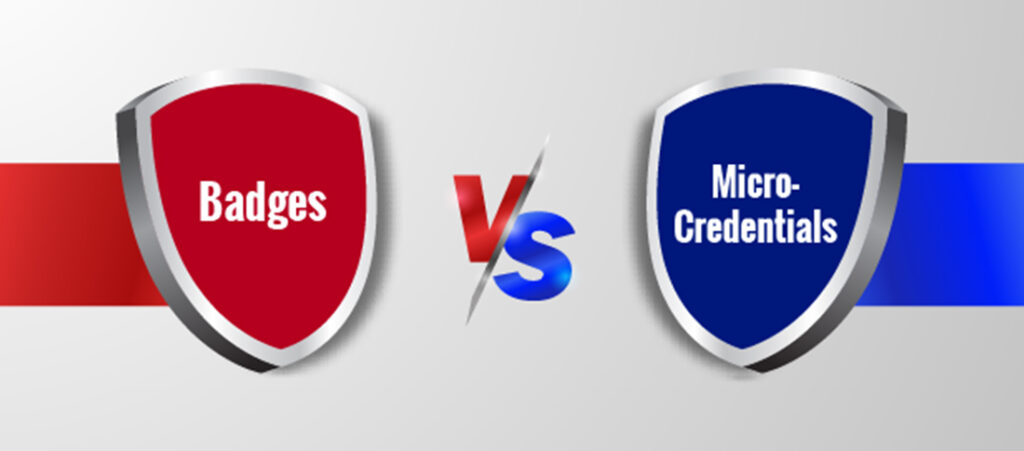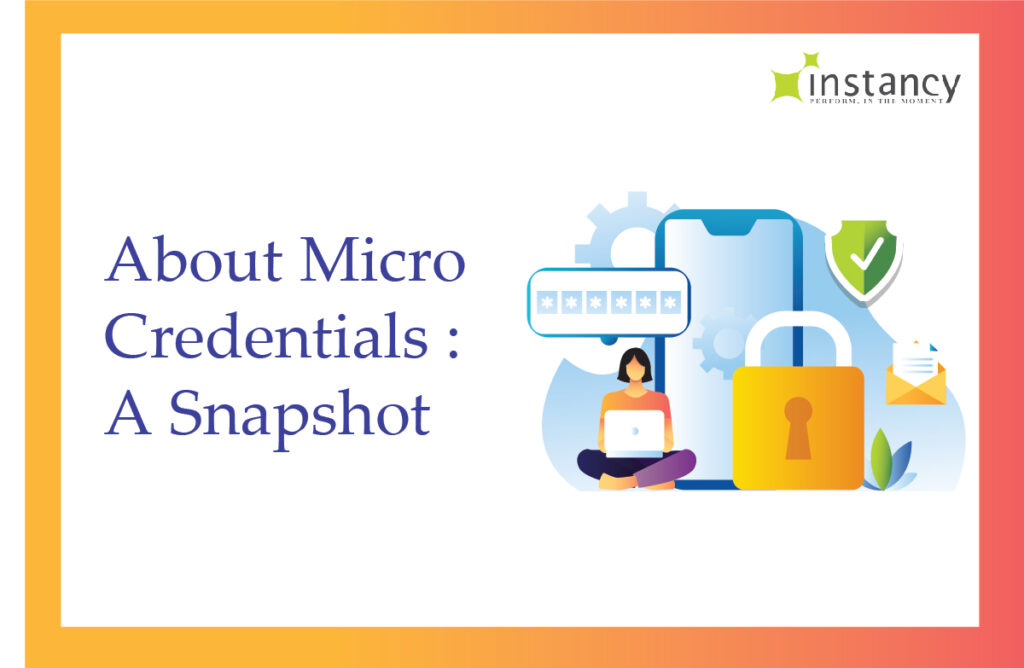Unfortunately, Covid-19’s long-term consequence is a knock to the economy, notably the employee market. Individuals need to stand out in a competitive job market now more than ever, and micro-credentials help them do so.
Micro-credentials, which focus on in-demand talents, are a straightforward way for people to learn new skills, explain their knowledge, and stand out from the crowd. This article explores the concept of micro-credentials and how they can help you upscale your profile significantly.
Table of Contents
- What are Micro-Credential?
- What are digital badges, and how do you get them?
- How can You Acquire Micro-Credentials?
- Benefits of Micro-Credentials
- Which Skills Can You Acquire?
What are Micro-Credentials?
In simplistic terms, what are micro-credentials? The word is comprised of two root words: “micro,” which means “tiny,” and “credential,” which means “qualification.” As a result, the following is a fundamental definition of micro-credential:
Micro-credentials are certification-style documents containing a certified statement about a person’s competence in a particular field. After completing an online course or a learning path, a person can earn a micro-credential in a digital certificate or ‘digital badge.’ This innovative approach to education is gaining traction and is in high demand among professionals as more businesses are beginning to accept such credentials for employment purposes.
Micro-credentialing began with computer programming skills, but it has since expanded well beyond that. LinkedIn is a leading example that highlights different sorts of micro-credentials available. Coursera, too, offers micro-credentials such as Specializations, Professional Certificates, and Master Tracks. Professional Certificates, Micro Bachelors, and Micro Masters are available through edX.
What Are Digital Badges and How Do You Get Them?
A micro-credential is also known as a “digital badge” or “digital credential.” The names are frequently used interchangeably, even though there is a significant distinction between them. A digital badge is its diploma if a micro-credential is a smaller, more compact version of a full-fledged degree. The digital badge is a visual depiction of micro-achievement credentials.
It provides information about the learner, the badge issuer, the requirements for earning the badge, and evidence that the conditions have been met. It is shared on social media, included in resumes and professional profiles, and even stored in “wallets” of digital badges.
Badges have existed for as long as humans have been required to demonstrate their authority through their knowledge or skill proficiency. They have been related to visual proofs of substantial achievement in an organization for the past century. Scout merit badges and military challenge coins are two good examples. Collecting them satisfies basic human desires for accomplishment, esteem, and respect.
Badges as physical symbols of achievement transitioned to digital form after the millennium. So, how does one go about obtaining a digital badge? Complete the badge-representing micro-credential course. Any useful micro-credential can be earned in the same way. Depending on the qualification, they can take a few hours to a year to complete.
The learner first enrolls in the course and attends the classes. The most common method is blended learning—this mix of traditional classroom instruction, self-paced individual study, and some lectures and seminars. Read on to find out the various evaluation paths through which a user can earn credentials.
Micro-credentials have a narrower range than standard certifications such as diplomas or degrees that need formal instruction, but they are also more expansive than motivational badges. The following section explores the main differences between badges and micro-credentials.
How Are Badges Different from Micro-Credentials?
At the course level, a badge may be awarded to the learners informally. Most badges are unmoderated, and they are frequently related to the achievement of learning objectives and course outcomes.
On the other hand, an organization formally grants a micro-credential, usually by a recognized entity such as a human resources department or training institute. As a result, micro-credentials have more perceived value from a job or career perspective than a badge received informally with a course awarded by the course instructor.
Micro-credentials have been recognized within a business or an institute, if not a whole industry. Badges have value in the context of a course. A well-thought-out micro-credentialing program could help your organization establish itself as a leader in certifying people’s skills and knowledge in job roles and industry.
As a result, badges can motivate students to strive toward a specific objective. They are valid within the context of the course or training. The badges recognize achievement on assessments, such as in a compliance course where a student must achieve a perfect score on a quiz.
On the other hand, micro-credentials take a different approach, although they resemble badges. For their students, micro certificates might be a source of inspiration. Learners are motivated to improve a specific skill or gain knowledge to achieve a bigger upskilling goal that could be part of a more extensive program. Because they can indicate a learner’s skills in a subject or a skill area, they are helpful in workplace professional development and beyond.
Micro-credentials can also be achieved by demonstrating skill in a specific area. They place a focus on competence. Micro-credentials can thus be classified as badges. However, not all badges represent the worth of a micro-credential.

How can You Acquire Micro-Credentials?
It can take a few weeks to a year to earn a micro-credential. The training and evaluation path varies by qualification, but one or a mix of the following could be used as an example.
- Tests, Assignments, and Projects – Initially, learners are expected to complete tests, assignments, and projects to demonstrate theoretical knowledge of the topic.
- Lectures and Seminars — As part of your organization’s micro-credentialing process, you may incorporate a lecture or seminar component that exposes your employees to the newest ideas and research in the field
- Present a Portfolio of Work in The Area — As part of the process, users may present a portfolio of work in the field to their team or direct report to demonstrate their skill set in the area.
- Assessments — As part of the micro-credentialing process, an assessment component, such as examinations or practical exercises, may be included.
- Conferences – As part of their exposure to skills, practices, and research in the subject, learners may have the opportunity to attend local or international conferences.
- Demonstrate Skills in the Workplace — Finally, users may be requested to show that they can successfully apply their talents in the job.
Benefits of Micro-Credentials
There is no denying that micro-credentials have many advantages. These bite-sized courses are the perfect combination of industry and educators, and they are perfect for revolutionizing any learning program.
These are the main benefits that one can reap from micro-credentials:
- Personalization for Employees
Micro-credentials allow employees to focus on a specific topic or job duties. Give your team members the option of picking a topic that interests them. Whether you are a large or small company, this allows you to personalize your training program easily. Rather than investing in an extensive, standard curriculum for departments or teams, you can tailor clustered micro-credentials to individuals to suit their career aspirations and duties. Your employees could wind up with their own set of micro-credentials tailored to their specific needs.
- Tailored Learning Approach
Educators are constantly looking for new methods to generate revenue for their institutions outside of the standard course structure, and micro-credentials provide a unique opportunity to do so.
Micro-credentials enable educational institutions to collaborate with large corporations to develop a customized learning strategy. They help free up educators to do what they do best: build knowledge-driven courses, while businesses may benefit from courses tailored to their specific needs. Many educators create introductory courses on popular topics and then customize them for more extensive collaborations, saving even more resources.
- Recognition
Employees like being recognized for their soft and hard skills, but describing, quantifying, and qualifying the skills and knowledge acquired on the job can be difficult. Traditional credentials do not provide a solution, but a micro-credential (for example) can be used to recognize an employee’s unique ideas over time by awarding a distinctive micro-credential.

- Stackable in a Continuous Learning Proces
Micro-credentials can be stacked indefinitely. Learners can combine an individual micro-credential with a complete credential, such as a professional development certificate, to achieve full credentials in a more significant area of interest, such as agile project management. These credentials can also represent a single certification or one or more learning paths because they are stackable. For example, a micro certificate in written communication could lead to a more prominent certification in technical writing, proposal writing, or even marketing as a field.
- A Methodical Approach to On-the-Job Training
Micro-credentialing provides an organized method for on-the-job training and development for you and your staff. Often, on-the-job abilities are not recognized or recorded, and they don’t appear on the employee’s record or CV. Micro-credentials flexibility and progressive nature mean you have a tool to give employees more structure and assessment in the skillset and knowledge they acquire in their role.
- Training in Emerging Areas
Quickly training employees to fill emergent skill shortages can be critical in fast-paced company situations. Due to a unique market opportunity, technology, or product strategy, your company may need to tap into new skill sets that are not currently available. Traditional credentials can be time-consuming to implement, and they may not cover all the skill sets you need. Micro-credentialing allows you to quickly train individual employees in certain areas, allowing you to take advantage of growing market opportunities or respond to technological advances promptly.
- Specialized Skillsets
Micro-credentials allow organizations to solve specialized skill gaps that regular credentials may not provide. You may need a staff member to apply interdisciplinary skill sets in a single function, or the skill gap you encounter may be particular to your organization. To teach your personnel, you may need a unique combination of micro-credentials.
- Tracking Personnel Skill and Talent Development
Micro-credentialing can help you manage your people and corporate resources more effectively. Employee capabilities can be measured, as well as enterprise-level skills and knowledge. They can help you quantify capabilities for planning objectives and gather vital data about staff abilities. The information may be used to manage your HR supply, estimate resource needs and training gaps, and develop an effective HR strategy.
Micro-credentials give you a tool to examine and manage your most critical resource – your personnel – whether you are planning for annual peak seasons or long-term market trends.
You can design a bespoke program to meet this specialized skill set deficiencies using the flexibility of micro-credentials and the opportunity for a more granular approach to addressing skill demands. The program can be functional whether you need soft talents, hard skills, or a combination of both. You might want to teach an employee a variety of digital marketing and data analytics and provide them with opportunities to practice soft skills like problem-solving and emotional judgment.
- Scalable and Personalized Training
Micro-credentialing is a highly scalable method of employee training. Rather than committing to a big-scale training program, whether you’re a large or small company, you can implement training programs in various segments. You may cut immediate expenses by pausing to evaluate the effectiveness of each micro-credential and then refine your strategy with more micro-credentials. Furthermore, a highly tailored approach to training may prove to be more beneficial for upskilling personnel than a broad-based, identical program for all team members.

- Assists In the Discovery Of Talent
Micro-credentials can help you discover your learners’ hidden skills. Micro-Credentials assist in sharing skills and knowledge areas, allowing people inside an organization to know whom to contact for assistance. An individual’s digital portfolio could include micro-credentials in gamification or robotics. The individual’s colleagues and network are aware that they should approach that person for information or assistance. As a result, sharing this information as an organization can make it much easier to rapidly discover the right candidate for a specific area of expertise.
- Encourages Life-Long Learning
Employees can earn micro-credentials, which are a fantastic way to keep them engaged. They are shareable demonstrations of personal accomplishment that can help you stay motivated. These physical proofs of on-the-job skills and expertise can be added to their personnel file and resume. Micro-credentials involve recognizing ground-breaking ideas and achievements that will be remembered for a long time. This kind of encouragement increases their prospects of moving up in the organization. Micro-credentials also highlight the job-seekers worth to potential future employers.
Which Skills Can You Acquire?
Employees can be trained in both soft and hard skills using micro-credentials. While formal qualifications emphasize complex abilities, soft skills such as leadership, problem-solving, and communication are also critical in the workplace. Organizations may fully use their workforce strengths by providing micro-credentials in both areas to employees on an as-needed basis.
Knowledge-based, or ‘hard’ skills, are learned through education and experience and are typically a mandatory talent that contributes to a role’s overall skill set.

The following are instances of hard skills:
- Front-End Web design and development
- Social Media Data Analytics Digital Marketing
- Soft abilities
Soft skills are adaptable skills that may be applied to various vocations; they are just as vital as hard skills. Soft skills are critical in generating business outcomes; they contribute to team efficiency, implying that the formalization of soft skills through micro-credentialing could significantly change how a professional practice operates.
Soft skills include:
- Self-Management or Teamwork
- Service to Customers
- Leadership Qualities
- Customer Service
- Problem-Solving
- Critical Thinking
You will be introduced to a more organized form of learning and training by participating in the micro-credentialing process. Job-learned abilities are sometimes overlooked since there has never been a straightforward way to formalize this knowledge through a recognized certificate or ‘badge.’
Employees are given a systematic approach. They can easily measure and formalize the information and skills learned thanks to the opportunity to build on these talents via a cumulative outlook. Employees can grow in their current role and their professional careers by participating in this type of professional learning.
Conclusion
As a recognized source of certifications and certificates, Instancy believes that on-the-job training should be acknowledged through the means of various certifications and credentials. Through the power of instancy’s authoring tools, you can create your own branded certificates with the utmost ease. To discover more, Click here. We can also help your company create a customized training program that meets your needs, thanks to our well-demonstrated ability to integrate business, learn together, and provide adaptable assessment and recognition solutions. For more information on how we can collaborate with you, contact our team now.




